From Wikipedia, the free encyclopedia
Enterprise real-time communications server, providing the infrastructure for enterprise instant messaging, presence, file transfer, peer-to-peer and multiparty voice and video calling, ad hoc and structured conferences (audio, video and web) and PSTN connectivity.These features are available within an organization, between organizations, and with external users on the public internet, or standard phones, on the PSTN as well as SIP trunking.
In February 2009 Microsoft released the R2 version of the server which runs solely on 64-bit platforms and is more scalable. R2 adds new features such as Group Chat and Attendant Console. Some of the roles of OCS are supported in virtualized environment.
From Wikipedia, the free encyclopedia
More Details. . .
Wednesday, December 1, 2010
Sunday, November 7, 2010
First Look: Windows Phone 7 Series Hands on Demo
This is it! What you've all been waiting for: your first look at Windows Phone 7. Corporate Vice President of Windows Phone Program Management Joe Belfiore gives us a full demo of the announcements being made today at Mobile World Congress, including:
- The new user experience
- Integration with social networks like Facebook
- Internet Explorer
- Photos, videos, and music
- E-mail and texting
- GPS and maps
- Search integration
- Hardware standards
Thursday, November 4, 2010
Windows 7 and Windows Server 2008 R2 Service Pack 1 Release Candidate (KB976932)
Windows 7 and Windows Server 2008 R2 SP1 Release Candidate includes previous updates delivered over Windows Update as well as continuing incremental updates to the Windows 7 and Windows Server 2008 R2 platforms.
Download Now. . .
Download Now. . .
Wednesday, November 3, 2010
Best Registry Cleaner for Windows 7
Corruption within your registry keys, registry classes, and registry settings are the most common causes of Windows error messages.
Download Trail Now. . .
Download Trail Now. . .
Windows Phone 7 "easier than iPhone, Android, BlackBerry"
By Richi Jennings. November 3, 2010.
Microsoft claims that Windows Phone 7 allows users to do things with up to 20% fewer operations than other smartphones. The company says WP7 is more efficient than Android, BlackBerry BBOS, or iPhone iOS. In IT Blogwatch, bloggers ask, "Really?!"
More Details. . .
Microsoft claims that Windows Phone 7 allows users to do things with up to 20% fewer operations than other smartphones. The company says WP7 is more efficient than Android, BlackBerry BBOS, or iPhone iOS. In IT Blogwatch, bloggers ask, "Really?!"
More Details. . .
Tuesday, November 2, 2010
Using Restricted Groups
Author: Derek Melber
If you are a medium or large sized organization, you might have thousands of clients and hundreds of servers that you need to manage. Manually trying to manage all of the local groups on all of these computers is difficult, and almost impossible. Have no fear, Group Policy Objects (GPOs) are here! GPOs provide a mechanism that allows you to control the membership in local groups, and even domain groups, on any computer in the Active Directory enterprise. The specific configuration that you use for this task is the Restricted Groups GPO setting.
More Details. . .
If you are a medium or large sized organization, you might have thousands of clients and hundreds of servers that you need to manage. Manually trying to manage all of the local groups on all of these computers is difficult, and almost impossible. Have no fear, Group Policy Objects (GPOs) are here! GPOs provide a mechanism that allows you to control the membership in local groups, and even domain groups, on any computer in the Active Directory enterprise. The specific configuration that you use for this task is the Restricted Groups GPO setting.
More Details. . .
Labels:
group,
policy,
restricted,
windows
.NET Framework Setup Verification Tool
Check your installed version of .NET Framework
http://blogs.msdn.com/b/astebner/archive/2008/10/13/8999004.aspx
http://blogs.msdn.com/b/astebner/archive/2008/10/13/8999004.aspx
Saturday, October 30, 2010
A Trail Operation Manager From ManageEngine (30 Days)
OPManager:
Resolve network outages quickly, troubleshoot
performance bottlenecks and get the visibility you
need to be in control of your network.
Try it Now. . .
Resolve network outages quickly, troubleshoot
performance bottlenecks and get the visibility you
need to be in control of your network.
Try it Now. . .
Labels:
manageengine,
manager,
operation
Network Access Protection (NAP)
by Susie Bernard (March 2007)
Whether your organization is small, medium, or large, deploying an enterprise software solution like Network Access Protection (NAP) requires careful planning. Deploying NAP involves network infrastructure design evaluation, how clients connect to that network, and what criteria those clients need to meet to be considered compliant. Detailed planning increases the probability that your NAP deployment will be a success
For Details Click Here. . .
Whether your organization is small, medium, or large, deploying an enterprise software solution like Network Access Protection (NAP) requires careful planning. Deploying NAP involves network infrastructure design evaluation, how clients connect to that network, and what criteria those clients need to meet to be considered compliant. Detailed planning increases the probability that your NAP deployment will be a success
For Details Click Here. . .
Labels:
access,
nap,
network,
protection
Tuesday, October 26, 2010
Free Online Virus Scanner
Microsoft http://onecare.live.com/site/en-us/default.htm
BitDefender http://www.bitdefender.com/scanner/online/free.html
Norton http://security.symantec.com/sscv6/WelcomePage.asp
Kaspersky http://www.kaspersky.com/virusscanner
ESET http://www.eset.com/online-scanner
Panda http://www.pandasecurity.com/homeusers/solutions/activescan/
McAfee http://home.mcafee.com/Downloads/FreeScan.aspx?ctst=1
F-Secure http://www.f-secure.com/en_EMEA/security/tools/online-scanner/
AVG http://www.avg.com.au/resources/web-page-scanner/
Wake On LAN (WOL)
323551-B21 HP-Compaq 10/100 Nc3121 PCI Fast Ethernet Wake On Lan
Written by: Annoyances.org
Wake on LAN (WOL) is a standard that allows you to turn on a computer from another location over a network connection.
Why would you want to use WOL?
Requirements:
Configuring your Network Card:
In order for WOL to work, your network card must go into "standby mode" when you power down your computer. If any of your network card's lights are still lit after you shut down, then it's configured properly, and you can skip the rest of this section. Othewise, if none of the lights remain lit after powering down, you'll need to do the following.
Waking a Computer Remotely with WOL:
In order to wake a shut-down computer with WOL properly configured, you need a program that can send the proper packets over your network. The following programs do this:
More Information:
Written by: Annoyances.org
Behind the Clouds [Vinyl]
Written by: Annoyances.org
Wake on LAN (WOL) is a standard that allows you to turn on a computer from another location over a network connection.
Why would you want to use WOL?
- If sharing an internet connection, you might want to turn on the "host" computer from one of the clients.
- If accessing your home PC from work, or your work PC from home, you might want to turn it on remotely to get to your files, and then shut it down when you're done.
Requirements:
- You must have an ATX 2.01 (or above)-compliant power supply, and an ATX motherboard with a WOL connector.
- You must have a WOL-compliant network card with a WOL connector. An example is the 3Com Fast Etherlink XL PCI 3C905B-TX, but not the 3Com Fast Etherlink XL PCI 3C905B-TX-NM (non-managed).
- Compare the WOL pin descriptions for your network card and for your motherboard. The must be identical; otherwise, your motherboard or power supply may be damaged.
- Your BIOS must support WOL, and the WOL option in your BIOS setup must be enabled. If you don't see a WOL option, check the manufacturer of your motherboard for an updated BIOS.
- Your network card drivers must also support WOL; check with your network card manufacturer for the latest drivers.
Configuring your Network Card:
In order for WOL to work, your network card must go into "standby mode" when you power down your computer. If any of your network card's lights are still lit after you shut down, then it's configured properly, and you can skip the rest of this section. Othewise, if none of the lights remain lit after powering down, you'll need to do the following.
- Double-click the Network icon in Control Panel, or right-click on your Network Neighborhood icon and select Properties.
- Select your WOL-compliant network adapter from the list, click Properties, and choose the Advanced tab.
- Highlight NDIS Driver Version, and change it's value to NDIS 4 (the default setting is Auto Select). If either the Advanced tab or the NDIS Driver Version setting are missing, then you'll need to obtain more up-to-date drivers from the manufacturer of your network card.
- Also in the Advanced tab, change the settings for Wake on Link and Wake on Magic Packet accordingly, if they're there.
- When you're done, click Ok, and then Ok again. Confirm that you want to restart Windows when asked.
- After restarting, shut down and check the light again. If it still doesn't work, contact from the manufacturer of your network card for support.
Waking a Computer Remotely with WOL:
In order to wake a shut-down computer with WOL properly configured, you need a program that can send the proper packets over your network. The following programs do this:
- LANDesk Client Manager, revision 3.10 or later, by Intel. This software comes with most WOL-compliant motherboards.
- Magic Packet by Advanced Micro Devices (AMD). This software is a free download from AMD.
More Information:
- The website for the manufacturer of your motherboard (i.e. Supermicro, Asus, Intel, etc.) will probably have additional tips, troubleshooting, and updates necessary to use WOL on your system.
- wol - Wake On LAN client
- Wake up to Wake-on-LAN (IBM)
Written by: Annoyances.org
Behind the Clouds [Vinyl]
Labels:
lan,
on,
wake,
wake on lan
Saturday, October 23, 2010
ServerSentinel - The Monitoring Tool for Servers
ServerSentinel is the reliable and automated monitoring software for servers, network services, such as HTTP, POP3 and IMAP, hard drives and memory usage. With various monitoring sensors and individually definable testing intervals, ServerSentinel monitors systems for failures and irregularities.
If failure or irregularity is tracked, ServerSentinel notifies you in real time via e-mail, text-to-speech output or acoustical warning sound. This immediate notification allows taking precautions to avoid system failure and limitation of availability.
ServerSentinel can take immediate action by running automatic scripts or programs that can take corrective actions as needed. Logged failures, reported irregularities and other performance data will be stored in a dedicated database. All recorded data can be used for future analyses regarding system failures and server performance bottlenecks which guarantees reliable control of all systems.
With ServerSentinel, you have your servers under control.
Friday, October 15, 2010
Monday, October 4, 2010
Try IE9 Beta NOW. . .
From Wikipedia, the free encyclopedia
Windows Internet Explorer 9 (abbreviated as IE9) is the upcoming version of the Internet Explorer web browser from Microsoft. It is currently available as a public beta version, released on September 15, 2010.
IE9 supports the HTML5 video and audio tags and the Web Open Font Format. Some industry experts claim that Microsoft will release IE9 as a major out-of-band version that is not tied to any particular version of Windows.
The system requirements for IE9 are Windows 7 or Windows Vista SP2 (with Platform Update and IE8); Windows XP is not supported.Both 32-bit and 64-bit builds are available.
Download Now. . .
Windows Internet Explorer 9 (abbreviated as IE9) is the upcoming version of the Internet Explorer web browser from Microsoft. It is currently available as a public beta version, released on September 15, 2010.
IE9 supports the HTML5 video and audio tags and the Web Open Font Format. Some industry experts claim that Microsoft will release IE9 as a major out-of-band version that is not tied to any particular version of Windows.
The system requirements for IE9 are Windows 7 or Windows Vista SP2 (with Platform Update and IE8); Windows XP is not supported.Both 32-bit and 64-bit builds are available.
Download Now. . .
A Great free Antimalware from Microsoft "Microsoft Security Essentials"
From Wikipedia, the free encyclopedia
Microsoft Security Essentials (MSE) is a free antivirus software product created by Microsoft that provides protection against different types of malware such as computer virus, spyware, rootkits and trojan horses for Windows XP (x86), Windows Vista, and Windows 7 (both x86 and x64).Microsoft Security Essentials replaces Windows Live OneCare, a commercial subscription-based anti-virus service and the free Windows Defender, which only protected users from adware and spyware. Unlike Microsoft Forefront family of enterprise-oriented security products, Microsoft Security Essentials is geared for consumer use.
Microsoft Security Essentials received positive reviews upon its release.
Labels:
antimalware,
antivirus,
Essentials,
microsoft,
security
Personal WDS on Windows Server 2008 R2 Implementation Guide
- Install, configure and update Windows server 2008 R2.
- Add WDS (Deployment and Transport servers) and DHCP roles.
- Download and Install the recent version of Windows AIK.
- DHCP Configurations:
- Create a scope and configure it with the required options.
- Reference Computer Configurations:
- Install windows, drivers, updates and applications.
- Copy the “deploy” (including the sysprep files) folder from the windows DVD from the “Support” folder into the partition that you want to capture.
- From the “Deploy” folder user the “Setupmgr.exe” to create an answer file for the mini setup wizard (sysprep.inf) and place it in the same folder as your sysprep files.
- Use the “sysprep.exe” to sysprep the partition using mini, reseal and reboot options.
- The client computer will restart, you can go to the Bios to check that the computer will be able to boot from the LAN (PXE).
- Don’t go to the next step until you finish the WDS configurations.
- When the computer restarts make sure you boot from LAN and after having an IP from the DHCP server press F12 to start connecting to the WDS server.
- From the list of boot images select the capture image you created on the server and continue with the wizards until you have the complete imaged from this computer inside the image group you created.
- WDS Configurations:
- Server Properties:
- General Tap:
- No Configurations.
- PXE Response Tap:
- Select “Respond to all client computers (known and unknown)” option
- Clear “Require administrator approval” option
- PXE Response delay: 0
- ADDS Tap:
- Default Configurations.
- Boot Tap:
- For known and unknown clients select “Require user to press F12”
- No default boot image.
- Client Tap:
- Check “enable unattended installation” option and point to the .xml answer file located in “C:\RemoteInstall\WdsClientUnattend”. (This is for Windows PE phase)
- Leave other option to default.
- DHCP Tap:
- Check both check boxes.
- Leave other taps to default configurations.
- From the Windows 7 DVD inside the “Sources” folder copy the “boot.wim” file to your server hard disk.
- From the WDS console inside “Boot Images” add a new boot image and point to the Windows 7 boot.wim file.
- Right click on the newly created boot image and select “Create Capture Image”
- Now you should have 2 images and both are x86, if you need a x64 bit images you should repeat the steps but use the boot.wim file from Windows 7 x64 DVD:
- The first boot image is for booting the client computer for installing the new install image.
- The second capture image is for capturing an image from a reference computer.
- Go to the “Install Images” node and right click and select “Add image group” with any name.
- If you didn’t uploaded the install image from the reference computer to the WDS server through the capture wizard yet you can right click on “Install Images” node and select “Add install image” and point to the .wim file taken from the reference computer.
- Now you can install this image on any client computer by booting the computer from LAN and use the first boot image (not the capture image) and when prompted select the install image you want and the setup will start.
- Answer Files Configurations:
- We have 2 answer files that we will use:
- Sysprep answer file (sysprep.inf) for the mini setup wizard:
- Created by the Setupmgr.exe from the deploy folder and placed on the sysprep folder on the reference computer.
- Windows PE answer file (unattend.xml) for the Windows PE setup phase:
- Download a sample from the web and customize it with “Windows system image manager” from the Windows AIK tools and place it inside the WDS configuration in the “Client” tap.
- Extra Configurations:
- You can open and manipulate the .Wim files by using “ImageX” command line tool from Windows AIK tools:
- Open CMD and go to this path “Program Files\Windows AIK\Tools\x86”
- Create a folder in C:\ called “mount PE”
- To mount the .wim file (extract it) use (where “c:\winpe\boot.wim” is the path to .wim file):
- ImageX /mountrw c:\winpe\boot.wim 1 c:\mountPE
- Now you can open the folder “mountPE” and start manipulating the files.
- To dismount the .wim file back use:
- ImageX /commit /unmount c:\mountPE
Labels:
deployment,
services,
wds,
windows
Windows Deployment Services
Labels:
deployment,
services,
wds,
windows
Free Network Monitoring Software
From SpiceWorks.com:
Looking for network monitoring software? From Spiceworks easy-to-use interface you can:
Download Now. . .
Looking for network monitoring software? From Spiceworks easy-to-use interface you can:
- Create & view alerts for Windows events
- Monitor the health of your MS Exchange server
- Monitor network bandwidth
- Track disk space, software installs, anti-virus subscriptions, toner levels, offline servers & more
Completely Free.
Spiceworks is completely free…and you can get started in less than 5 minutes.Download Now. . .
Monday, September 27, 2010
Third-party Apps For Blogger
Third-party Apps
A list of cool third-party apps that integrate with Blogger in some way. Since these are third-party applications, standard disclaimers apply: your mileage may vary, you could experience data loss, we're not responsible if things go haywire, etc
A list of cool third-party apps that integrate with Blogger in some way. Since these are third-party applications, standard disclaimers apply: your mileage may vary, you could experience data loss, we're not responsible if things go haywire, etc
Labels:
Apps,
Blogger,
Third-party
IT Dictionary
Type any IT term you want to know and a list of will display instantly, choose that term to see its meaning. You can double click on any word on the screen to find out its meaning.
Labels:
dictionary,
information,
it,
technology,
wiki,
wikipedia
List of information technology topics
From Wikipedia, the free encyclopedia
Information technology (IT), as defined by the Information Technology Association of America (ITAA), is "the study, design, development, implementation, support or management of computer-based information systems, particularly software applications and computer hardware."IT deals with the use of electronic computers and computer software to convert, store, protect, process, transmit, and retrieve information.
Information technology (IT), as defined by the Information Technology Association of America (ITAA), is "the study, design, development, implementation, support or management of computer-based information systems, particularly software applications and computer hardware."IT deals with the use of electronic computers and computer software to convert, store, protect, process, transmit, and retrieve information.
Labels:
information,
it,
technology,
wiki,
wikipedia
What is Information technology ?
From Wikipedia, the free encyclopedia
Information technology (IT) is "the study, design, development, application, implementation, support or management of computer-based information systems, particularly software applications and computer hardware", according to the Information Technology Association of America (ITAA).IT deals with the use of electronic computers and computer software to securely convert, store, protect, process, transmit, input, output, and retrieve information.
Information technology (IT) is "the study, design, development, application, implementation, support or management of computer-based information systems, particularly software applications and computer hardware", according to the Information Technology Association of America (ITAA).IT deals with the use of electronic computers and computer software to securely convert, store, protect, process, transmit, input, output, and retrieve information.
Labels:
information,
it,
technology,
wiki,
wikipedia
Windows XP will not report a successful print job to the system log by default
By default Windows XP will not record an event for a successful print operation (job) in system log, but if you want Windows XP to do so (Because you are using a print monitoring software that collect its data from system log for example) I will show you how:
From "Start" menu select "Printers and Faxes"
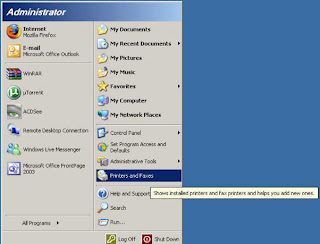
From "File" menu select "Server Properties"
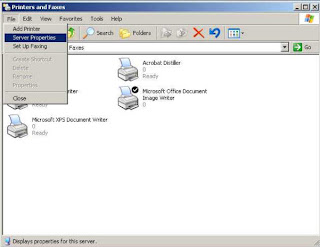
Go to "Advanced" menu
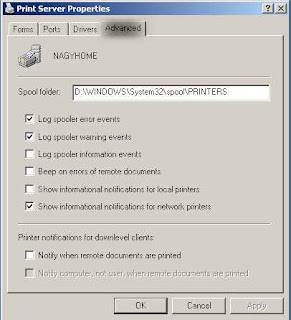
Check the "Log spooler information events" option (This option is checked by default on Windows Server 2003)
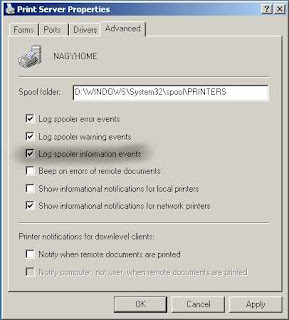
Now when you make a successful print job ,the print server will record an "information" event in system log
The event showing the file name, size, number of pages, user name ,printer name ,date and time.
Nagy
31-12-2008
11:50 PM
From "Start" menu select "Printers and Faxes"

From "File" menu select "Server Properties"

Go to "Advanced" menu

Check the "Log spooler information events" option (This option is checked by default on Windows Server 2003)

Now when you make a successful print job ,the print server will record an "information" event in system log
From "Start" menu open "Administrative tools" and select "Event Viewer"
You will find event(s) similar to this one
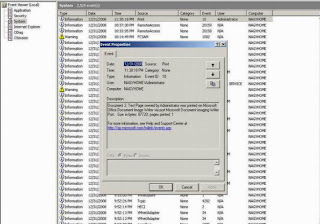
You will find event(s) similar to this one

The event showing the file name, size, number of pages, user name ,printer name ,date and time.
Nagy
31-12-2008
11:50 PM
Subscribe to:
Comments (Atom)